In the vast expanse of the starry sky, numerous constellations can be observed. However, the question arises: what exactly is a constellation? Despite our familiarity with this term, its true meaning may not be clear to those who do not have an interest in astronomy. If one were to inquire about the definition of a constellation from such an individual, the response would likely be incoherent. Most people might simply state that it is:
While this initial definition is rather vague, it fails to provide a clear understanding of which specific groups of stars it refers to. Are all groups considered constellations, or are there specific principles that dictate how stars are grouped together?
A more precise definition is presented in the second statement; however, it too requires further clarification. For instance, despite being a well-known star pattern, the Big Dipper is not considered a constellation. On the other hand, attempting to discern any recognizable pattern within the constellation Lynx proves to be quite challenging!
What does the term “constellation” mean in astronomy?
Astronomy is a field of study that has been around for centuries and, like any other scientific discipline, it continues to evolve. This evolution also applies to the concept of constellations.
The role of constellations in ancient times
In ancient times, constellations were known as distinct patterns formed by groups of stars that were easily recognizable and memorable.
Why were these patterns important? They served as a means of navigation and timekeeping.
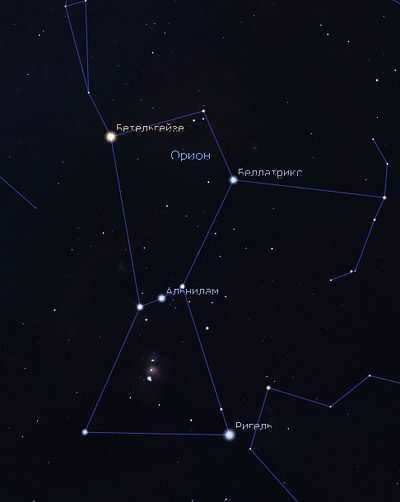
The constellation Orion consists of seven of the brightest stars that form a shape resembling an hourglass. While this formation is commonly referred to as a constellation, it is technically an asterism. Image: Stellarium
In ancient times, the sky served as both a clock and a compass for our ancestors. Farmers used the sky to determine the timing of planting and harvesting, while nomadic tribes relied on it for navigation. The Sun, Moon, and stars were all utilized for these purposes.
The stars possess a unique characteristic in that their relative positions in the celestial sphere remain unchanged for hundreds, and even thousands, of years. It appears as though they are firmly fixed in the firmament, making them an ideal backdrop for observing the movement of the moon and sun, and for creating calendars or telling time.
However, with so many stars in the sky, it can be easy to become disoriented. To address this, people began grouping stars into constellations.
Some of the oldest constellations date back at least 5000 years. These include the Zodiac constellations and some constellations that are visible near the polar constellations. The ancient Greeks, around 2-2.5 thousand years ago, identified a total of 48 constellations in the sky. Most of these ancient constellations have distinct patterns and feature at least one prominent star.
What is the meaning of a constellation in modern times?
Astronomers now refer to bright, easily recognizable star formations as asterisms.
For instance, the Big Dipper, mentioned earlier, is not considered a constellation but an asterism. It is actually just a small part of the larger constellation known as Ursa Major. Another example is the hunter Orion, which is composed of seven bright stars.
However, this was not always the case. In the past, constellations did not have clearly defined boundaries. Areas of the sky that were not part of the vividly illustrated constellations were filled with unclaimed stars. As a result, astronomers divided these areas as they saw fit, creating more and more constellations in the night sky.
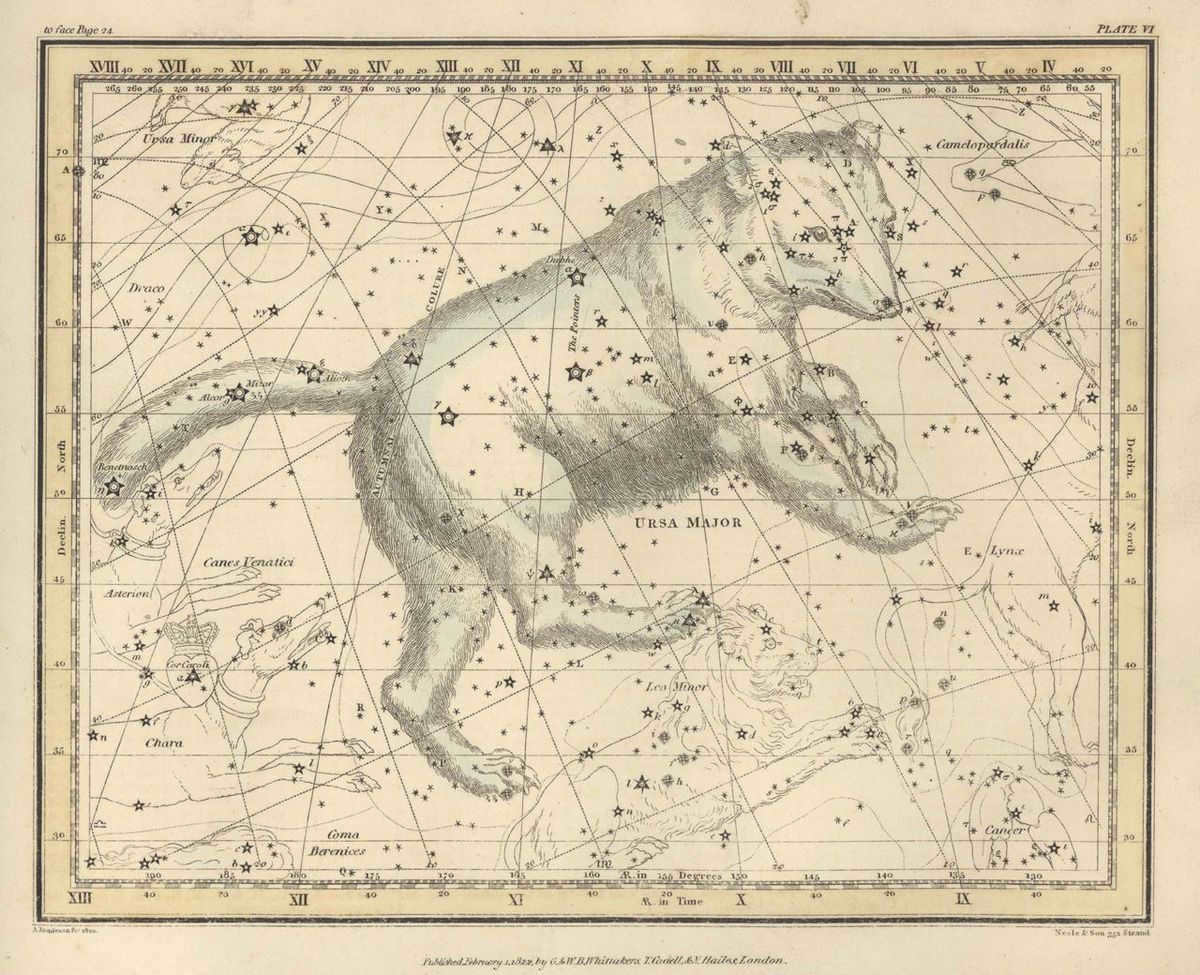
The Big Dipper constellation, as depicted in Alexander Jamieson’s atlas from 1822, is defined by the author with arbitrary boundaries. These boundaries are represented by a dotted line. (Click on the image to view it larger.) Source: Ian Ridpath
In the first half of the 20th century, this practice was discontinued. During the general assembly of the International Astronomical Union in Rome in 1922, it was decided to divide the entire sky into regions with clear and fixed boundaries, which would not be altered again.
This marked the emergence of the modern constellations.
So, what constitutes a constellation today?
- Constellations at the household level are referred to as expressive and memorable star groups (asterisms). This custom dates back to ancient times.
- From the perspective of contemporary astronomers, constellations are defined as specific areas of the sky with well-defined boundaries. (There are no unclaimed areas in the sky; even the darkest and starless regions belong to a constellation.)

The constellation known as the Big Dipper is represented in a contemporary manner with well-defined boundaries. The Big Dipper asterism forms a component of the Big Dipper constellation. Source: IAU
Constellations differ from asterisms
It’s worth emphasizing that asterisms are what constellations used to be in ancient times. These are memorable groups of stars that were associated with everyday objects, animals, or mythical characters. Nowadays, an asterism can either be a part of a constellation (like the Big Dipper) or consist of stars from different constellations (like the Summer Triangle).
A constellation, on the other hand, is a defined area of the sky with clear boundaries. It’s worth noting that the boundaries of constellations are determined solely based on lines of declination or right ascension.
Constellations are not physical objects, but rather directions in the sky
Many people mistakenly believe that constellations are tangible entities, similar to large clusters of stars. This misconception is sometimes reinforced by science fiction writers who depict countries acquiring ownership of imaginary constellations, such as Russia claiming the constellation of Cancer and the United States claiming Sagittarius. In these fictional stories, space travelers navigate through various constellations, like Shield, Virgo, and Veronica’s Hair.
However, these descriptions are humorous because constellations are not actual objects, but rather markers that indicate specific areas in the sky. Therefore, the question of whether a constellation or a galaxy is larger is irrelevant, as they are fundamentally different concepts.
Constellations are not tangible; you cannot physically travel to them, just as you cannot travel to a location like “to the right”. However, you can observe them and discover what they contain. (To provide an analogy: you cannot go “as far east” but you can see what is in the east!)
Objects within the same constellation – such as stars, nebulae, and galaxies – are located at varying distances from us: some are just a few light years away from Earth, while others are hundreds or even thousands of times farther. Nevertheless, they are all so remote that we cannot discern the differences in these distances with the naked eye. As a result, it appears to us as if they are all equidistant – positioned on the celestial sphere. (And we, gazing at the starry sky, are situated at the center of that sphere.) Thus, constellations serve as indicators of directions within the celestial sphere.
Humans were the ones who invented constellations
It’s important to note that constellations were not naturally occurring, but rather a creation of our ancestors! They exist solely as a product of human imagination, setting them apart from other objects like fossilized animal bones. While discovering a new species of dinosaur is possible by finding unique bones, the same cannot be said for constellations. They can only be invented, not discovered.
It’s worth mentioning that different nations used to have their own distinct constellations. Nowadays, we primarily use European constellations, but in the past, Native Americans, ancient Indians, and Chinese cultures had their own unique constellations.
You might wonder, can I also create my own constellation?
Sure! Everyone has the ability to create their own constellations, or more accurately, asterisms. Some individuals find this activity incredibly thrilling. It’s so enjoyable to gaze up at the night sky on a balmy summer evening and search for fresh arrangements!
Additionally, asterisms can be not only sizable and visible to the naked eye, but also small and composed of faint stars that can only be seen through binoculars or a telescope. Even today, new asterisms are being invented! A few of them (like the Ring of Diamonds in Ursa Minor) are truly stunning.

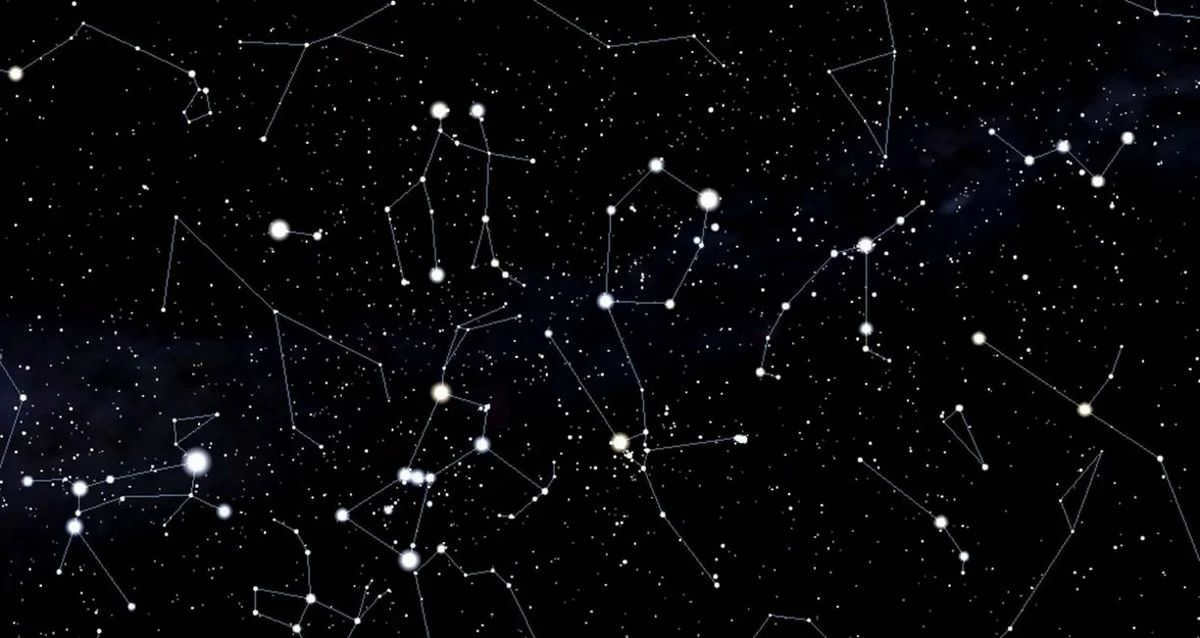
Universe
Have you ever laid on your back on a sunny day, gazing at the heavens and seeing large, fluffy clouds that resemble pieces of cotton? Often, these clouds seem to transform into the shape of animals or even human faces. Well, constellations are essentially the same. They are imaginary figures that are formed by the arrangement of stars in the sky.
The nighttime sky is like a canvas covered in a multitude of tiny dots. Since ancient times, people have been discovering various images hidden among these stars.
Who was the original creator of star constellations?

It is well-known that 4,000 years ago, the ancient Sumerians were the first to document constellations. Naturally, individuals interpreted what they saw in the sky based on their own perceptions. For example, hunting tribes identified star formations that resembled the wild animals they pursued. Similarly, European navigators discovered constellations that resembled the shape of a compass. In fact, scientists believe that the primary purpose of constellations was to aid in navigation while sailing the sea.
Legends and myths about constellations
There is a tale that recounts how the spouse of the Egyptian ruler Berenice (Veronica) presented her magnificent hair as a gift to the goddess Venus. However, the hair was pilfered from Venus’ storeroom and ascended to the heavens as a constellation. During the summer, the constellation Veronica’s Hair can be observed in the Northern Hemisphere below the handle of the Bucket of the Big Dipper.
Various cultures have categorized the stars into constellations in diverse manners. Some of the narratives surrounding the formation of the constellations were exceedingly peculiar. Take, for instance, the depiction that the ancient Egyptians envisioned of the constellation encircling the Bucket of the Big Dipper. They perceived a bull, with a man reclining beside him, being dragged along the ground by a hippopotamus who walked on two legs and bore a crocodile on its back.
There are many tales rooted in Greek mythology that explain the origins of constellations. Let me share one with you. The goddess Juno became envious of her maid Callisto, who had caught the eye of Juno’s husband, Jupiter. To shield Callisto from harm, Jupiter transformed her into a bear. However, this transformation created a new dilemma. One day, Callisto’s son went out hunting and came across his mother in bear form. Mistaking her for just any ordinary bear, the young man raised his bow and took aim. Jupiter swiftly intervened and, in order to prevent the killing, turned the young man into a small bear cub. This is how, according to legend, the prominent constellations known as the Big Dipper and the Little Dipper came to be in the night sky.
The Significance of Constellations in Modern Times
There are 88 constellations on modern star maps, dividing the Northern and Southern Hemispheres. It is believed by scientists that the majority of these “modern” constellations were documented approximately 2600 BC. While it may appear that the stars within the constellations are closely grouped together, this is actually an optical illusion. In reality, the stars within constellations are separated by vast distances of trillions of kilometers. Interestingly, some more distant stars may appear brighter and indistinguishable from closer, less bright stars. When observed from Earth, constellations appear flat.

Stars, much like individuals, experience birth and death, and are constantly in motion. As a result, constellations evolve over time. A million years in the past, the current configuration of the Big Dipper did not resemble a ladle, but rather a lengthy spear. It is conceivable that in a million years, new names will be required for constellations, as their shapes are bound to change. Lastly, it is possible that there exists a planetary system where our Sun appears as a small star, forming part of a constellation whose inhabitants perceive the outline of their native exotic creature.
A fascinating video about stars and constellations
If you happen to come across an error, kindly select the text and press Ctrl+Enter.

From ancient times, people have relied on the stars to navigate their surroundings, whether it be finding their way back home, embarking on long seasonal migrations, or even venturing across vast oceans to discover new lands.
However, instead of relying on individual stars, they turned to constellations, which served as the primary beacons in the night sky.
How did these constellations acquire their names and become essential for navigation?
What role did they play in shaping human history?
And which constellations do we still rely on today?
Constellations are formations of stars in the nighttime sky that can be described as creating an outline, a design, or a specific form that holds significance for people.
They might simply be the name by which they are recognized, or they might be how our predecessors marked the seasons.
Usually, these designs symbolize animals, religious or mythological figures, or an inanimate object that holds cultural importance.
Constellations themselves do not have the same meaning across different cultural groups, and as the stars’ positions change over time, so do the shapes of the constellations. Therefore, the constellations that our ancient ancestors observed in the nighttime sky were likely different in appearance from the ones we are familiar with today.
Overview of constellations through history
The origins of constellations can be traced back to ancient times, with the earliest known evidence of their existence found in the renowned rock art at Lascaux, France, approximately 17,000 years ago.
There are some who speculate that Gobleki Tepe, an ancient temple in Turkey constructed around 12,000 years ago, might have served as an observatory, with its carved columns potentially depicting ancient constellations. However, there is currently no concrete evidence to support this theory.
Further exploration into the past indicates that the oldest recorded constellations may have been documented by Babylonian astronomers during the second millennium BC. Nevertheless, it has been suggested that the Babylonians themselves may have been influenced by earlier Sumerian traditions.
China has astronomical records dating back to around 3000 BCE, and the first Chinese star catalogs were created in the 4th century BCE.
It is possible that these star catalogs were influenced by the Babylonians, potentially through India.
The modern constellations that we are familiar with in the Western world are derived from ancient Greek sources, which were based on old Babylonian star charts.
The two main Greek works on constellations that we know about are Aratus Phenomenon and Ptolemy’s Almagest, both of which list the 48 traditional constellations found in the northern sky.
The major constellations in the southern sky were established in the 15th century when European explorers began to map out the southern sky.
However, it is possible that ancient Polynesians utilized advanced astronomical navigation techniques based on the movement of specific stars across the nighttime sky in order to navigate the open ocean as early as 1200 BC.
In 1922, the International Astronomical Union established a formal catalog of 88 contemporary constellations, defining their “territory” in the sky in 1928.
The purpose of these official designations was to divide the celestial sphere into recognizable regions, making it easier for astronomers to observe and identify celestial objects by their corresponding constellations.
As an instance, Sagittarius A* represents a supermassive black hole situated at the core of the Milky Way galaxy, and its precise position in the nocturnal sky can be ascertained by identifying the Sagittarius constellation and refining observations based on that reference point.
What is the total count of constellations?
Presently, there are officially recognized 88 constellations, which were established in 1922 by the International Astronomical Union (IAU).
In addition to these 88 recognized constellations, there exist numerous informal yet identifiable star patterns that are utilized across various cultures and are referred to as asterisms.
These asterisms may constitute a part of one or more constellations.
For instance, the stars forming the Plow or the Big Dipper are asterisms located within the Big Dipper constellation, and the stars commonly associated with “Orion” are actually asterisms within the Orion constellation.
The constellations that can be observed in the night sky during the evening undergo changes from season to season, as the stars appear to shift by 90 degrees across the celestial sphere every three months.
While certain constellations remain visible throughout the year in the northern or southern latitudes, the view of the sky varies depending on the location and time of the year.
On average, the stars move approximately 15 degrees per hour, completing a full rotation of 360 degrees in 24 hours.
Some constellations rise directly in the east and set directly in the west, taking longer to traverse the sky, while others follow shorter paths, remaining closer to the horizon before disappearing below it.
As they move across the sky, the stars maintain their relative positions.
The constellations we are familiar with may appear larger or smaller at different times of the night and may appear sideways or upside down at different times of the year. However, their overall shape remains constant throughout our lifetime.
During the summer and winter, the constellations we see in the sky are different. This is because the stars actually move about 15 degrees in under an hour and complete a full circle in 23 hours and 56 minutes.
In other words, each night the stars rise and set approximately four minutes earlier. In the remaining four minutes, they travel about 1 degree. This means that they move about 361 degrees per day.
Over time, these extra degrees accumulate, causing the stars to rise and set an hour earlier every two weeks, two hours earlier every month, and eventually returning to their original position after a year.
With the change of seasons, the arrangement of star constellations varies across different regions of the sky due to the movement of stars by approximately 90 degrees between each season.

When we talk about “seasonal constellations,” we are usually referring to the constellations that are visible in the sky around 9 PM or the constellations that are best observed at specific times of the year.
However, it is important to note that these are not the only constellations that can be seen in the sky on any given evening.
For instance, Andromeda, which is a well-known fall constellation, can be observed high overhead on summer evenings around midnight.
Similarly, Orion, which is the dominant constellation in the winter sky during the evening, can also be seen in late summer when it rises just before dawn.
Below is a list of constellations that are considered seasonal:
In earlier eras, groups of prominent stars were identified as constellations and named after characters from mythology (such as Andromeda and Hercules) or common objects (like Libra and Pump). These names, while conventional, only loosely correspond to the actual shapes of the constellations.
Nevertheless, the concept of constellations proved highly practical, making it easier to track time and navigate both the celestial realm and the Earth’s surface. Even in modern times, astronomers and navigators continue to recognize and utilize the division of the sky into constellations.
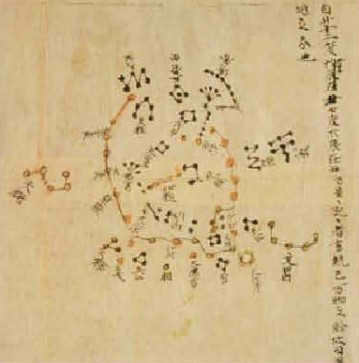
A specific depiction of the night sky in the northern latitudes is portrayed in a Chinese star chart discovered in Dunhuang. This historical artifact dates back to approximately 700 AD and originates from the Tang dynasty.
During the 16th century, the round-the-world voyages carried out by Magellan and other travelers resulted in the creation of modern constellations that have no connection to mythology. In the 17th to 19th centuries, numerous star chart compilers introduced new constellations. For instance, there was a consensus among astronomers to include important scientific instruments such as the Microscope, Telescope, Circulus, and Compass in the sky. However, the European monks’ attempts to “Christianize” the sky by replacing the mythical figures with characters from the Holy Scriptures were not accepted. Likewise, the names of European monarchs were not immortalized in the heavens. The International Astronomical Union’s First General Assembly in Rome in 1922 put an end to all efforts to modify the celestial sphere by definitively defining the names of 88 constellations that cover the entire sky.
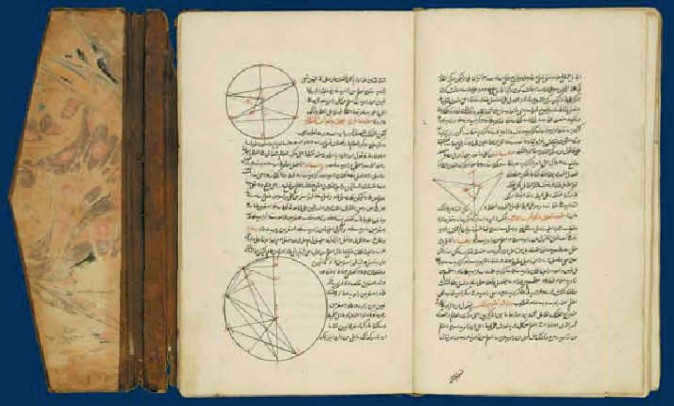
In the present day, constellations are no longer considered as groups of stars, but rather as areas of the sky that contain various astronomical objects. As a result, the definition of a constellation now primarily involves drawing its boundaries. These boundaries are designated by broken lines that follow the lines of equal declination and direct ascension, making it easier to represent them mathematically. The process of delineating the boundaries between constellations was finalized in 1932.
Constellations are symbols of ancient human culture, representing its mythology and early fascination with the stars. Certain constellations were recognized as early as the Bronze Age, a time when our ancestors were just starting to understand the world and study the movements of the Sun and Moon.
Within the constellations, certain stars are identified using letters from the Greek alphabet, arranged in descending order of brightness. The brightest star in the constellation is designated as α (alpha), followed by β (beta) as the second brightest, and so on. Among the 275 brightest stars, each has its own name that was given to them in ancient times. Many of these names have Arabic origins, such as Aldebaran, Algol, Deneb, and Rigel. One particularly well-known star, which is used for navigation and determining the direction to the North Pole, can be found in the Little Dipper. It is called Polaris. Additionally, some prominent stars are named after the astronomers who first discovered and described their unique characteristics. For example, Barnard’s star is named after the American astronomer Edward Emerson Barnard (1857-1923), and Kapteyn’s star is named after the Dutch astronomer Jacobus Cornelius Kapteyn (1851-1922). However, it’s worth noting that our Galaxy contains over 100 billion stars, and only a small fraction of them (approximately 0.004%) have been cataloged. The majority of stars remain unnamed and are not even accounted for.
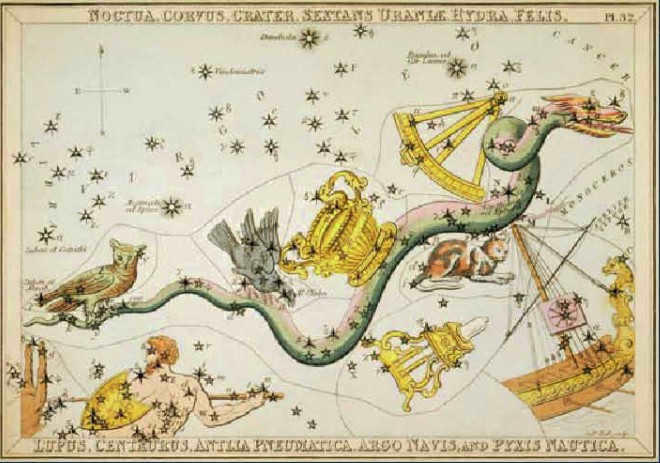
The constellation Owl, which is located on the tail of the largest constellation in the sky, Hydra, is no longer officially recognized. Similarly, the constellation Cat, found on the opposite side of the map, has also lost its official status. The Urania Mirror star atlas depicts these changes, as well as other constellations such as Raven, Cup, Sextant, Centaurus, Pump, Argo Ship, and Compass.
Variable stars are identified with Latin uppercase letters ranging from R to Z, followed by combinations of each of these letters with each of the following – from RR to ZZ, and then combinations of letters from A to Q with each of the following – from AA to QZ (excluding the letter J, as it can be easily mistaken for I). There are a total of 334 letter combinations possible. Therefore, if additional variable stars are discovered in a constellation, they are designated with the letter V (from the English word “variable”) and a sequential number starting from 335, along with the three-letter designation of the constellation. For instance, R Lyr, S Car, RT Per, V557 Sgr, and so on.
Zodiacal constellations
In order to remember the paths of the Sun and Moon, the people of Mesopotamia, Phoenicia, Greece, and other Eastern Mediterranean regions marked the most significant stars through which they travel in the sky. As a result, the oldest constellations are those that the Sun passes through in its annual motion – known as the ecliptic. There are a total of 13 such constellations. Twelve of them were used as a calendar, with the Sun spending approximately one month in each. These constellations are mostly named after real or mythical animals, which is why they are referred to as zodiacal constellations (zodiac in Greek means circle of animals). The zodiacal constellations include Aries, Taurus, Gemini, Cancer, Leo, Virgo, Libra, Scorpio, Sagittarius, Capricorn, Aquarius, and Pisces.

What makes the Big Dipper constellation so renowned?
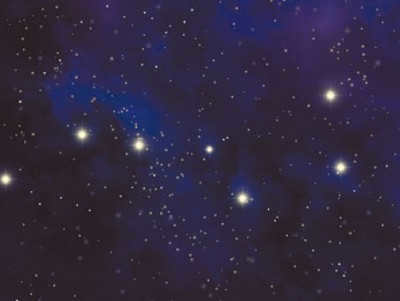
The constellation known as the Big Dipper is particularly noteworthy. The seven most brilliant stars in this constellation resemble a large spoon or container with a lengthy handle. The constellation’s popularity stems from its constant visibility in the night sky. However, during the autumn season, it remains close to the horizon, while during summer nights, it can be seen directly overhead. In the spring, the Big Dipper can be located in the eastern portion of the sky, and in late summer, it can be found in the western region. It appears as though the Big Dipper tires of staying in one place and occasionally takes a leisurely stroll across the celestial sphere.

A unique position in the celestial realm is held by the zodiacal constellations, commonly known as the twelve signs of the zodiac. The term “zodiac” originates from the Greek language, meaning “circle of animals”. It is worth noting that eleven out of the twelve zodiacal constellations are named after living creatures, such as Aries (the ram), Taurus (the bull), Gemini, Cancer, Leo, Virgo, Scorpio, Sagittarius, Capricorn (the goat), Aquarius, and Pisces. Astrologers, who derive their name from the Greek words “astron” meaning “star” and “logos” meaning “thought” or “reason”, believe that the positioning of the stars has an impact on an individual’s life. According to their beliefs, being born under a specific zodiac sign can influence one’s personality traits.
The celestial canopy is not merely an assemblage of luminous specks set against a somber backdrop. The entire expanse of the firmament is partitioned into distinct segments known as constellations. These constellations, with their peculiar names and enigmatic forms, hold captivating tales waiting to be unraveled. However, it is crucial to begin by understanding the essence of constellations and the evolution that has shaped their present-day facades.
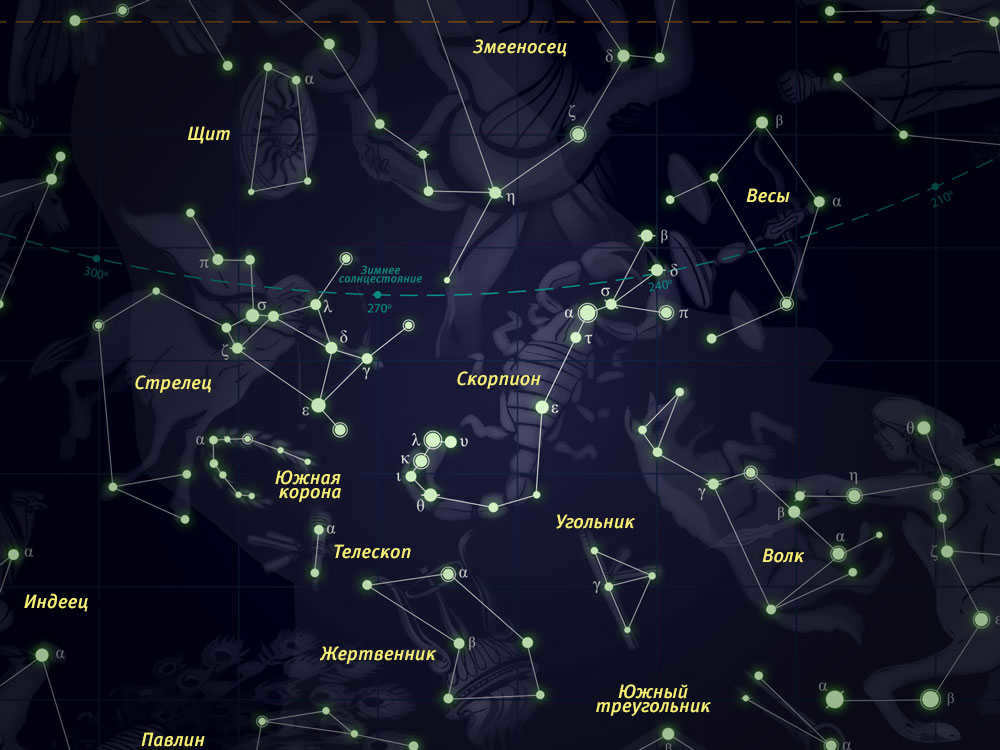
Ancient celestial heroes
When gazing up at the night sky, individuals often perceive various shapes and forms formed by the stars. These celestial patterns are often associated with familiar objects, animals, or even people. This is how the concept of constellations came to be. Each civilization had its own unique way of grouping the stars and interpreting their significance.
However, modern astronomy traces its origins back to the ideas and understanding of the ancient civilizations residing along the Mediterranean Sea. The ancient Egyptians and Babylonians, followed by the Greeks, played a crucial role in shaping our understanding of the cosmos. These ideas were then passed down through the Romans and Arabs, ultimately leading to the development of modern science. Therefore, it is not surprising that the names of stars and constellations reflect the cultural influences of these ancient civilizations.
Most notably in the celestial sphere, we can observe the presence of the legendary Greek heroes. Among them, one can identify nearly all the major figures from the tale of Perseus: Perseus himself, Princess Andromeda, her mother Cassiopeia, King Cepheus, the winged horse Pegasus, and even the fearsome monster, Kit.
Furthermore, the constellations pay tribute to several characters from the Hercules mythos, including both the hero himself and his adversaries: Hydra, Cancer, and Leo. Additionally, numerous constellations are dedicated to individuals (not exclusively human) who were “elevated to the heavens” by the Olympian deities under diverse circumstances. For instance, the Big Dipper and the Little Dipper represent Zeus’ paramour, the nymph Callisto, and her beloved canine companion, who were both transformed into wild animals. Aquarius encompasses multiple young men from Greek legends, although the prevailing interpretation identifies it as Ganymede, who famously served wine to the gods.
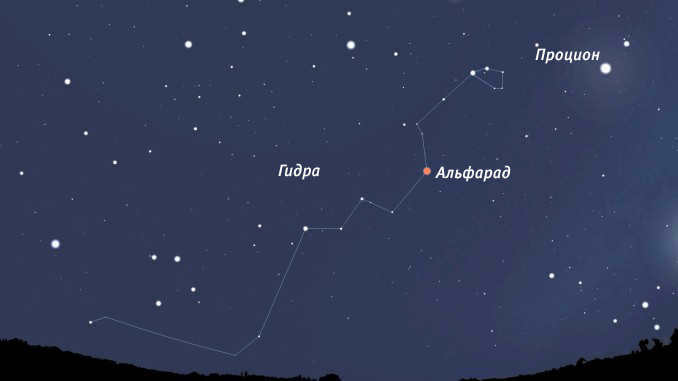
The Southern Sky: Star Catalogs and Telescopes
Initially, descriptions of the night sky focused on the depiction of constellations as figures. However, astronomers soon began to delve deeper into the study of the heavens, meticulously documenting all visible stars and creating comprehensive catalogs. One of the earliest and most notable of these documents is Claudius Ptolemy’s “Great Construction,” more commonly referred to by its Arabic title, the “Almagest,” which cataloged a total of 1022 stars.
Neither in 140 A.D., nor in the following centuries, was there any consideration given to the question of which constellation each position in these catalogs belonged to. It was only with the introduction of the telescope in Europe that it became apparent that there were far more stars than had been observed for millennia, and that they all needed to be given names or at least labels.
The concept of assigning each of these stars to one of the existing stellar patterns seemed like a logical solution. However, what should be done if an object in the sky is equidistant from different constellations or, for instance, located far away from any of the Greek heroes?
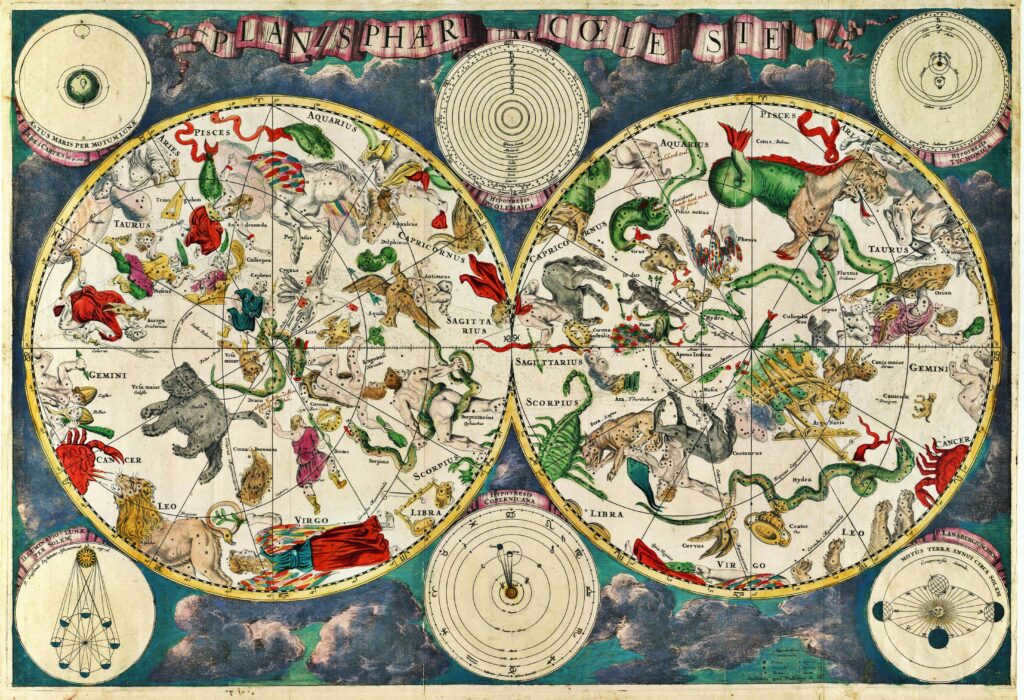
Furthermore, the sailors contributed to the labor at hand. They ventured into the southern regions and beheld constellations that were unfamiliar to both the Greeks and Egyptians. These celestial formations comprised of shapes that had never been observed before. It became evident that action needed to be taken, but it wasn’t until the 20th century that a definitive resolution was discovered.
New and historical constellations
The initial step taken by astronomers was to introduce constellations in areas where Ptolemy had not identified any, even though there were still stars left “uncovered”. These constellations were typically named after animals or objects. Consequently, the Lizard, Fly, Chameleon, Toucan, and Phoenix emerged in the celestial sphere, along with the Compass, Clock, Triangle, Chisel, and Sextant. The unique constellation of the Southern Cross held a special significance. Despite the absence of a counterpart to Polaris in the Southern Hemisphere, this cluster of stars serves as a guide for navigators to determine the south.

The destiny of the constellation Argo’s Ship is quite fascinating. It was originally included in Ptolemy’s atlas. However, astronomers eventually found it to be too large and decided to divide it into three separate parts: Sails, Stern, and Kiel. Additionally, some of the stars from this constellation were used to form a new constellation called the Compass.
Not all of the names given to the new constellations became widely accepted. For several centuries, astronomers competed in creating more and more new celestial figures. Some examples include Antinous, the Cock, the Bee, the River Tiger, the Pole Sentinel, the Little Cancer, the Cat, the Balloon, the Voltaic Battery, and even the Swords of the Kurfürst of Saxony. Despite their invention, these names never gained popularity.
The most recent constellation was created by German astronomer Gottfried Kirch as a way to impress his patron Johann Georg III. This endeavor may seem absurd if one were unaware that another astronomer, Jan Hevelius, had come close to achieving the same feat. The constellation, now recognized as the Shield, was initially referred to as Jan Sobieski’s Shield. Hevelius, driven by his enthusiasm, named it in tribute to the Polish king, who held sway over numerous Ukrainian territories during that period.


In 1627, German astronomer Julius Schiller took the idea of renaming constellations to another level. He was dissatisfied with the fact that the constellations in the sky had pagan names, so he suggested replacing them with Christian names. For example, the zodiac should be named after the twelve apostles. However, during the 17th century, the influence of the church was still strong, and very few astronomers supported these innovations.
Passions ceased to rage only in the 20th century. In 1922, the Second General Assembly of the International Astronomical Union introduced a new concept of constellations. Since then, this term has been used to refer not to a figure in the sky, but to a region of the sky that encompasses all the astronomical objects within it. However, disputes over the boundaries of constellations persisted until 1937, but eventually, order was established in the sky.
The modern celestial sphere is divided into 88 constellations, and there is not a single star that does not belong to any of them. This is why the names of these regions do not hold much significance. If desired, one can find anything they wish within them.
Simultaneously, it is important to keep in mind that we only observe a portion of the celestial sphere as it rotates. As a result, the availability of constellations throughout the year is dependent on the latitude of the observing location. For instance, at the equator, one can perceive all constellations. However, none of them are visible throughout the entire year. Conversely, at the poles, one celestial hemisphere is visible year-round (although the Sun is on it for half of the year), while constellations beyond it seem to be non-existent.
Ukraine’s Collection of Constellations
Ukraine holds a unique position in the world of stargazing. While the northern circumpolar constellations are always visible here, the rest of the northern constellations and some of the southern constellations can only be seen during specific seasons. Unfortunately, a significant portion of the southern constellations remains hidden from view.
Regrettably, certain constellations cannot be observed from Ukraine’s territory. The Southern Cross, for example, remains invisible to Ukrainian skywatchers. Additionally, the constellation of Carina, home to the second brightest star in the night sky, Canopus, does not rise above the horizon. Even our nearest celestial neighbor, α Centauri, remains out of sight.

Throughout most of the year in Ukraine, one can behold the alpha star of the Big Dog, known as Sirius, shining brightly in the celestial sphere. Its luminosity is so intense that on exceptionally clear days, even when it is situated far from the Sun, it remains visible to the naked eye amidst the brilliance of the sky.
Furthermore, numerous constellations possess their unique Ukrainian denominations. For instance, the Big and Little Bears are referred to as the Big and Little Buckets, respectively. Cassiopeia is known as Harona or Apiary. The modest Dolphin constellation is likewise called the Well, while the Eagle constellation bears the title of the Girl with Buckets.
Stars are often grouped together in clusters, and each cluster has its own unique name. Take, for instance, the three stars that make up Orion’s belt – Alnitak, Alnilam, and Mintaka. These stars are traditionally referred to as Kosari. In the constellation of Taurus, there is a scattered star cluster known as the Hyades, which is called Chepigi. Similarly, the Pleiades, another cluster of stars in Taurus, is referred to as Stozharas.
Get the most fascinating news and interesting facts delivered to our Telegram channel!






